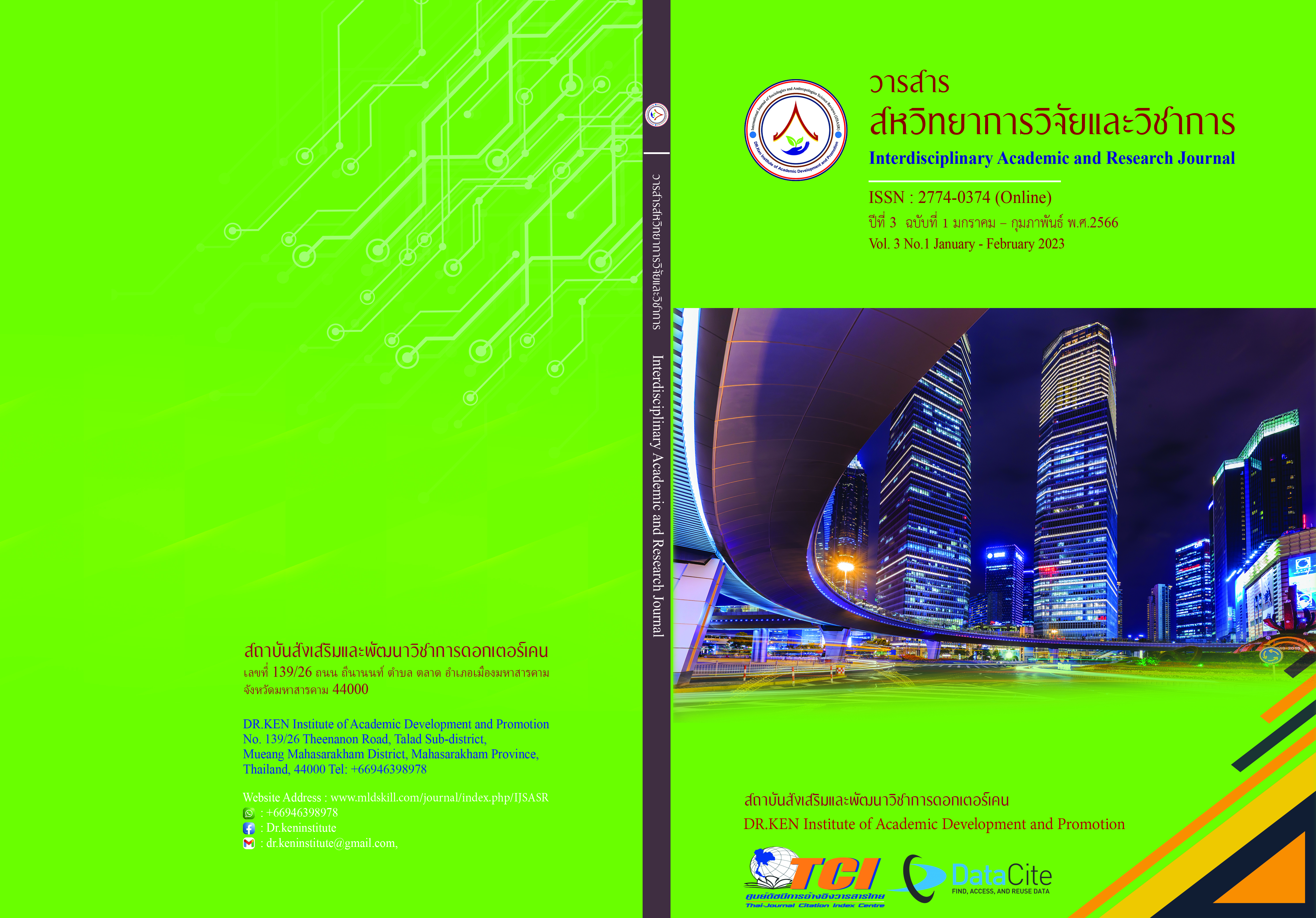Digital Marketing for Consumer Repurchases
DOI:
https://doi.org/10.14456/iarj.2023.10Keywords:
Repurchase Behavior; , Digital Marketing; , Digital Marketing CommunicationsAbstract
Today's business operations are the dimension of social e-commerce, online trade, which can be divided into 2 components: The first part is a social network that will act as a website that can add commercial features that allow for advertising and buying, and selling. And the second part is that e-commerce has enhanced the ability of social networks to enhance business competitive advantages. Thus, this article is a study of the key factors leading to consumer repurchase behavior in digital societies Digital marketing approach to supporting consumer repurchases The study found that 1) Consumers are critical to meeting their needs; There are four marketing components: product, price, distribution channel, and marketing promotion. It contributes to the repurchase decision. and 2) the key digital marketing approach is (1) marketing that values the perceived value of the product; Reasonable pricing compared to quality It is suitable compared to other stores and is suitable for economic conditions. (2) The service provided by the shop must be of high quality and consistent service. Professional in-service. The website should be modern, beautiful, and eye-catching. The process of ordering, shipping, and payment is hassle-free, as well as providing a full range of products. (3) Product quality Product uniqueness and product certification marks (4) Good quality of marketing communications, quality placing Marketing strategies using search marketing Use keywords to name your site so that your site is at the top of your search page. Online strategy for advertising through Facebook, including video clips on YouTube.
References
ฉัตรสุดา กลิ่นรอด และ สมชาย เล็กเจริญ. (2563). โมเดลความสัมพันธ์เชิงสาเหตุความพึงพอใจในการใช้บริการตรวจสภาพรถมือสองผ่านเพจเฟซบุ๊กของผู้บริโภคในเขตกรุงเทพมหานครและปริมณฑล. วารสารศิลปการจัดการ, 4 (2), 429-443.
ฉันธะ จันทะเสนา. (2562). ตัวแปรที่มาก่อนของการตั้งใจซื้อซ้ำในพาณิชย์อิเล็กทรอนิกส์ไทย. วารสารการพัฒนาทรัพยากรมนุษย์และองค์การ, 11 (2), 34-51.
ดลนภัส ภู่เกิด. (2562). ปัจจัยที่มีผลต่อการตัดสินใจซื้อสินค้าผ่านแอพพลิเคชั่นช้อปปี้ในกรุงเทพมหานคร. การค้นคว้าอิสระ บริหารธุรกิจมหาบัณฑิต สาขาการจัดการการตลาด บัณฑิตวิทยาลัย มหาวิทยาลัยสยาม.
ธัญญ์รวี ธรศิริปุณโรจน์ และคณะ (2562). กลยุทธ์การตลาดสู่ความสำเร็จของการประกอบธุรกิจผลิตภัณฑ์สปาผ่านช่องทางดิจิทัลในเขตกรุงเทพมหานครและปริมณฑล, วารสารสมาคมนักวิจัย. 24 (1), 72-84.
นภาพร ปิ่นภู่ (2560).กลยุทธ์การตลาดที่ส่งผลต่อความตั้งใจในการซื้อซ้ำสินค้าอุปโภคบริโภคผ่านระบบออนไลน์. การค้นคว้าอิสระ บริหารธุรกิจมหาบัณฑิต บัณฑิตวิทยาลัย มหาวิทยาลัยราชภัฎวไลยอลงกรณ์.
บุญฑริกา ตั้งอุดมสิริ. (2560). กลยุทธ์ในการสื่อสารการตลาดดิจิทัลสำหรับธุรกิจร้านอาหารเคลื่อนที่ (Food Truck) กรณีศึกษา ร้าน Answer Cheeze (แอนเซอร์ชีส). วิทยานิพนธ์ปริญญามหาบัณฑิต, มหาวิทยาลัยกรุงเทพ.
บุญสม รัศมีโชติ. (2561). การซื้อสินค้าซ้ำผ่านช่องทางการตลาดออนไลน์เว็บไซต์ Lazada ของผู้บริโภคในจังหวัดสมุทรสาคร. HUSO Journal of Humanities and Social Sciences. 2 (2), 14-34.
พิริยะ เงินศรีสุข. (2563). การสื่อสารการตลาดดิจิทัลสำหรับนักท่องเที่ยวกลุ่มเจนเนอเรชั่นซี. วารสารสหวิทยาการมนุษยศาสตร์และสังคมศาสตร์, 3 (2), 298-310.
วญาณ์กาญจน์ นุ้ยบุญแก้ว. (2560). พาณิชย์อิเล็กทรอนิกส์ (Electronic commerce) หรือ อี-คอมเมิร์ซ (e-Commerce). เอกสารวิชาการ.กลุ่มงานคณะกรรมาธิการการพาณิชย์และทรัพย์สินทางปัญญา สำนักกรรมาธิการ 1 สำนักงานเลขาธิการสภาผู้แทนราษฎร.
วรรณเทพ จันทร์จรูญจิต และ สมชาย เล็กเจริญ. (2563). รูปแบบความสัมพันธ์เชิงสาเหตุความภักดีที่ มีต่อตราสินค้ายูนิโคล่ผ่านสื่อสังคมออนไลน์ของผู้บริโภคในเขตกรุงเทพมหานครและปริมณฑล. วารสารปัญญาภิวัฒน์. 12 (3), 120–133.
ศิริวรรณ พันธุ. (2562). ปัจจัยที่ส่งผลต่อการตั้งใจซื้อซ้ำผลิตภัณฑ์สมุนไพรเสริมอาหารผ่านออนไลน์. วารสาร วิทยาการจัดการปริทัศน์. 21 (1), 63-71.
สำนักงานพัฒนาธุรกรรมทางอิเล็กทรอนิกส์. (2560). รายงานผลการสำรวจพฤติกรรมผู้ใช้อินเทอร์เน็ตในประเทศไทยปี 2560. Retrieved from: https://www.etda.or.th/publishingdetail/thailand-internet-user-profile-2017.html
สำนักงานพัฒนาธุรกรรมทางอิเล็กทรอนิกส์. (2560). รายงานผลการสำรวจมูลค่าพาณิชย์อิเล็กทรอนิกส์ในประเทศไทย. Retrieved from: www.etda.or.th
สิทธิ์ ธีรสรณ์. (2562). การสื่อสารทางการตลาด. พิมพ์ครั้งที่ 5. กรุงเทพฯ: สำนักพิมพ์จุฬาลงกรณ์มหาวิทยาลัย.
สุทธิดา บัวศรี และ สมชาย เล็กเจริญ. (2563). โมเดลความสัมพันธ์เชิงสาเหตุความตั้งใจในการซื้อซ้ำสินค้าผ่านแอปพลิเคชันของผู้บริโภคในเขตกรุงเทพมหานครและปริมณฑล. วารสาร มจร พุทธปัญญาปริทรรศน์, 5 (2), 82-93
หทัยชนก ว่องเจริญพร. (2565).การตลาดดิจิทัลที่ส่งผลต่อความพึงพอใจและความภักดีของลูกค้า. วิทยานิพนธ์บริหารธุรกิจมหาบัณฑิต คณะวิทยาการจัดการ มหาวิทยาลัยราชภัฎอุตรดิตถ์.
อรอนงค์ ทองกระจ่าง. (2560). การศึกษาส่วนประสมทางการตลาด การยอมรับเทคโนโลยี และการสื่อสารแบบบอกต่อที่มีผลต่อการตัดสินใจซื้อสินค้าผ่านทางแอปพลิเคชั่น Shopee. การค้นคว้าอิสระบริหารธุรกิจมหาบัณฑิต บัณฑิตวิทยาลัย มหาวิทยาลัยกรุงเทพ.
อัมพล ชูสนุก และคณะ. (2560). อิทธิพลของการรับรู้คุณค่าด้านราคาและด้านคุณภาพต่อความไว้วางใจ ความพึงพอใจการบอกต่อ และการกลับมาซื้อซ้ำของผู้บริโภคสินค้าไทยกูลิโกะในเขตกรุงเทพมหานคร. วารสารบริหารธุรกิจศรีนคริทรวิโรฒ. 8 (1), 13-26.
อาทิตยาพร ประสานพานิช. (2561). แนวทางการพัฒนาส่วนประสมทางการตลาดออนไลน์ของ โรงแรมในเขตพัฒนาเศรษฐกิจพิเศษ ภาคตะวันออกเฉียงเหนือ. วารสารวิชาการบริหารธุรกิจ, 7 (2), 10-25.
Chesshire, T., & Rowan, D. (2017). “How social networks are driving what you buy”, Commerce gets social. Retrieved 27 July 2017 from: http://www.wired.co.uk/magazine/archive/2011/02/features/social-networks-drive-commerce
Chih-Cheng, Chen, V., & Chen, C. (2017). The role of customer participation for enhancing repurchase intention. Management Decision, 55 (3), 547-562.
Chiu, C.-M., Hsu, M.-H., Lai, H., & Chang, C.-M. (2012). Re-examining the influence of trust on online repeat purchase intention: The moderating role of habit and its antecedents. Decision Support Systems, 53 (4), 835 - 845. doi:https://doi.org/10.1016/j.dss.2012.05.021
Dennison, G., Braun, S. B., & Chetuparambil, M. (2009). Social commerce defined. Retrieved March 14, 2011, from http://www-01.ibm.com/software/ genservers/commerce/socialcommerce
Hsu, L.-C. (2018). Investigating effect of service encounter, value, and satisfaction on word of mouth: An outpatient service context. International Journal of Environmental Research and Public Health, 15 (1), 1-15.
Werapongpradit, K., (2018). A survey of internet usage behavior in Thailand in January 2018-Part 2 Digital in 2018 in Thailand. Retrieved from: https://shorturl.asia/Imxre
Liang, L. J., Choi, H. C., & Joppe, M. (2018). Exploring the relationship between satisfaction, trust and switching intention, repurchase intention in the context of Airbnb. International Journal of Hospitality Management, 69, 41-48.
Lin, C. P., & Ding, C. G. (2005). Opening the black box: Assessing the mediating mechanism of relationship quality and the moderating effects of prior experience in ISP service. International Journal of Service Industry Management, 16, 55– 80.
Nadia, J., Sonia, S.-M., & Jose Ignacio, A. (2016). Trust and satisfaction: the keys to client loyalty in mobile commerce. Academia Revista Latinoamericana de Administración. 29 (4), 486-510.
Prasetya, Yafet, and Julfree Sianturi. (2019). Customer Repurchase Intention in Service Business: A Case Study of Car Repair Service Business. Management and Entrepreneurship: Trends of Development. 2 (8), 18-34.
Rain Maker. (2563). Data on consumer behavior for the year 2020. Retrieved from: https://ms-my.facebook.com/rainmakerth/photos/a.169644900342483/830976867542613
Kemp, S. (2020). DIGITAL 2020: THAILAND. Retrieved February 19, 2020, from: https://datareportal.com/reports/digital-2020-thailand
Downloads
Published
How to Cite
Issue
Section
License
Copyright (c) 2023 Pittayush Yanpitak, Patcharee Tabsuri, Chainarin Teerachaiyapat

This work is licensed under a Creative Commons Attribution-NonCommercial-NoDerivatives 4.0 International License.
Copyright on any article in the Interdisciplinary Academic and Research Journal is retained by the author(s) under the under the Creative Commons Attribution-NonCommercial-NoDerivatives 4.0 International License. Permission to use text, content, images, etc. of publication. Any user to read, download, copy, distribute, print, search, or link to the full texts of articles, crawl them for indexing, pass them as data to software, or use them for any other lawful purpose. But do not use it for commercial use or with the intent to benefit any business.
















.png)


